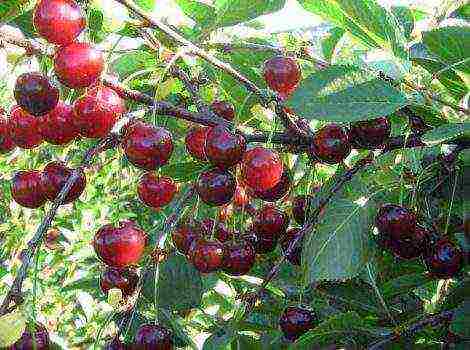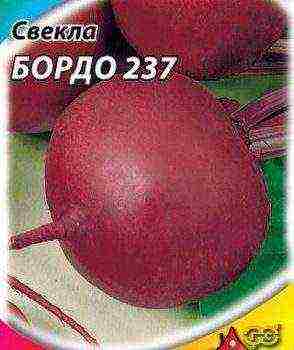Content
- 1 Juicy peach variety
- 2 Varieties and their description
- 3 Self-fertilized, self-fertile peaches: Inka, Vulcan, Harnas, Golden Jubilee
- 4 Early peach varieties 2018
- 5 Medium to late ripening peaches
- 6 New varieties of 2018
- 7 Peach varieties and the best yields (video)
- 8 Reviews and comments
- 9 The most popular early varieties include:
- 10 Mid-early varieties include:
- 11 Of the late varieties of peach, I would like to highlight:
Peach is a short-lived plant... It is distinguished by its rapid entry into the fruiting phase, intensive growth.
Peach buds have the ability to quickly awaken and release young shoots. The crown grows and if it is not thinned out, starting from the second year, then the yield will decrease.
From the fourth year, the peaches will become small and misshapen. Young trees begin to bear fruit in the second year after planting. With good care, they can give a crop in the first year, with autumn planting.
But this should not be allowed. Better to let the plant develop. You will collect a small crop, but time will be spent, and the plant will lose strength.
Table of contents
- Juicy peach variety
- Varieties and their description
- Ripen early: Kiev Early, White Swan, Grisborough and Redhaven, Morettini
- Medium ripening: Collins, Cardinal, Golden Moscow, Sibiryak, Saturn, Kremlin, Donskoy
- Late, frost-resistant: Fury, Frost, Veteran
- Self-fertilized, self-fertile peaches: Inka, Vulcan, Harnas, Golden Jubilee
Juicy peach variety
In the past, gardeners dreamed of peaches that can be grown in all regions of the country, not just in the south.
Today, their dreams have come true: breeders have developed many interesting winter-hardy, frost-resistant varieties with different fruiting times, fruit shapes and taste.
Peach trees are divided into four groups (depending on the shape of the fetus):
- Real peach is a plant with pubescent fruits.
- Nectarine or bare peach.
- Potanin's Peach (Potanin's Almond).
- Fergana peach or fig (flattened fruit).
 Peach trees are divided into four groups depending on the shape of the fruit.
Peach trees are divided into four groups depending on the shape of the fruit.
The timing of fruit ripening, the flowering period - it all depends not only on the area where the tree is grown, but also on the characteristics of the variety:
- Early maturing varieties give off the first fruits from July to August.
- Mid-season enter the fruiting phase in early August and delight with the harvest until September.
- Late peaches ripen in autumn: September, early October.
Which variety is best suited for a plot or garden depends on the climatic features of the area. It is important to choose plants so as to stretch the fruiting season for the whole season.
The yield of the plant depends on the correct choice of the variety. When buying a seedling, you need to pay attention to several important points, we give their description:
- Where did the seedling come from?... If the nursery is located in a different strip, then the seedling may die in the first year after planting or it will constantly freeze. The variety should be zoned, and the nursery should be in the same climatic zone (preferably even in the same region) where the tree will grow.
- Inspection of the scion site... It should be smooth and even, without bumps and hardened juice.
- Plant root system should have a fibrous shape. A root in one trunk is not good.
Annual seedlings take root better and delight with the harvest faster. When buying, it is better to focus on them, but choose strong, healthy plants, and not frail twigs.
Varieties and their description
Ripen early: Kiev Early, White Swan, Grisborough and Redhaven, Morettini
The peculiarity of early maturing varieties is that they quickly enter the fruiting phase. Two-, three-year-old seedlings are already producing a small harvest. Yields peak in the fourth to fifth year after planting.
When choosing early maturing varieties, it is better to focus on plants that have a low, spreading crown. They are easier to care for and shape during the growth period. Shorter trees are also easier to harvest.
Among the representatives of this group, varieties deserve special attention Kiev Early, White Swan and Redhaven.
Redhiven's crop peaks at 11 years of age. More than a hundred kilograms of fruit are harvested from one tree.
 The best early varieties of peaches: Kievsky Early, White Swan, Grisborough and Redhaven, Morettini
The best early varieties of peaches: Kievsky Early, White Swan, Grisborough and Redhaven, Morettini
Each variety of early peach is good in its own way and has a lot of advantages.
Benefits of early peach varieties:
- form a wide crown no more than 5 meters high;
- plants bloom in April-May;
- they enter the fruiting phase quickly: in the fourth year after planting the seedling;
- fruiting is extended from July to August;
- it has a high yield, aromatic and tasty fruits.
The first fruits appear on a mature, well-formed tree. This cannot but affect the yield: from a six-year-old tree, with proper care, you can harvest up to 60 kilograms of peaches.
Another prominent representative of this group is Grisborough variety... It is distinguished by medium vigor, but, unlike the aforementioned varieties, it has an average winter hardiness.
In order for the plant to bear fruit in mid-latitudes, it must be planted in calm places.
High winter hardiness pleases peach moretini... One of its advantages is a spreading crown that is easy to shape.
Morettini fruits are among the first to ripen, but have average transportability. This prevents the fruit from being transported over long distances.
Medium ripening: Collins, Cardinal, Golden Moscow, Sibiryak, Saturn, Kremlin, Donskoy
Medium ripening varieties allow the peach conveyor to continue.
Feature of plants of this species:
- high, spreading crown (from 5 meters);
- high productivity;
- good winter hardiness;
- large fruits.
Mid-season peaches have a huge number of varieties, but among them there are several types that show themselves perfectly in any conditions and do not require special care: Collins, Cardinal, Golden Moscow, Siberian, Saturn, Kremlin.
Variety Cardinal famous for its huge fruits (from 140 g) and excellent taste. This is one of the most delicious types of peach. On the international tasting scale, he received five points. This is the highest mark.
The plant is resistant to diseases, but it is difficult to tolerate recurrent frosts. It is better to plant it in a calm place, not far from the wall of a house or fence, but away from water.
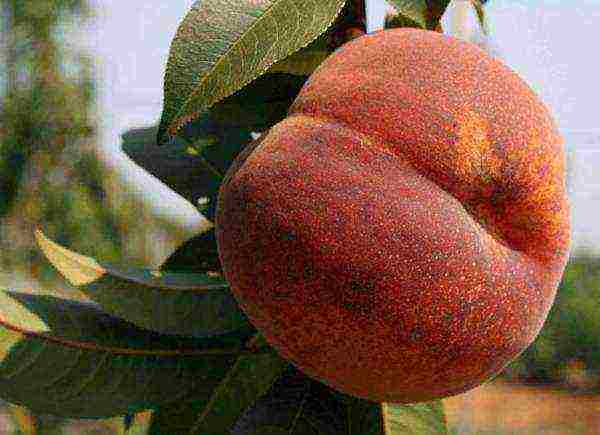 The best varieties of peaches of medium ripening: Collins, Cardinal, Zolotaya Moskva, Sibiryak, Saturn, Kremlevsky, Donskoy
The best varieties of peaches of medium ripening: Collins, Cardinal, Zolotaya Moskva, Sibiryak, Saturn, Kremlevsky, Donskoy
Kremlin peach adapts without problems to changes in temperature conditions, has high winter hardiness. Thanks to this, he attracted the attention of gardeners from regions where summers are cool. With good care, the fruits reach up to 200 g.
Variety Golden Moscow not so long ago appeared on the market, but its seedlings are very popular. The plant winters well and is resistant to diseases, has juicy large fruits.
The fruiting period stretches for almost three weeks. Peach blooms late, after the threat of frost return, and this increases the number of quality fruits.
Sibiryak variety highly regarded by farmers for its excellent transportability. The yellow fruit can be stored in a cold room for up to three weeks. In addition, they are tasty and juicy, and the bone is easily separated from the pulp.
The first crop is harvested in August, and the last fruits are removed in early September.
Peach Saturn stored no longer than 12 days. It's also a lot. The plant has high winter hardiness (up to -27). A strong crown complicates care and this affects the yield.
If the branches are tilted downward, then you can get an excellent harvest every year.
The most winter-hardy representative of this group is peach donskoy... It not only withstands severe frosts, but also quickly recovers after freezing.
The main advantage of peaches of the middle ripening period is high yield, transportability of fruits and excellent winter hardiness of the tree.
Most varieties have a juicy pulp and a pleasant aroma.... A high crown can be regarded as a disadvantage, but with the correct shaping of the tree, it is easily eliminated and turns into a virtue.
Late, frost-resistant: Fury, Frost, Veteran
Planted a peach, but it does not bear fruit, only intensively increases the crown? Do not be upset: it is better to be patient and wait a little longer.
Late-ripening varieties bear fruit starting at the age of 5 after planting a seedling. They are intended for cultivation in the southern regions. In the North and in the Middle zone, they do not have time to ripen and are sour.
American Fury withstands frosts down to -28 degrees. It is valued for its huge, up to 300 g, orange-colored fruits. The plant is undemanding to care.
The collection of fruits falls in September, when only apple and pear trees are left in the garden. The fruits are stored for no longer than six days.
Frost variety also bred by American breeders, who focused on winter hardiness and large-fruited plants.
The tree gives a high stable yield, withstands frosts down to -26 degrees, and is resistant to diseases. The fruits are used for fresh food. Stored for ten days.
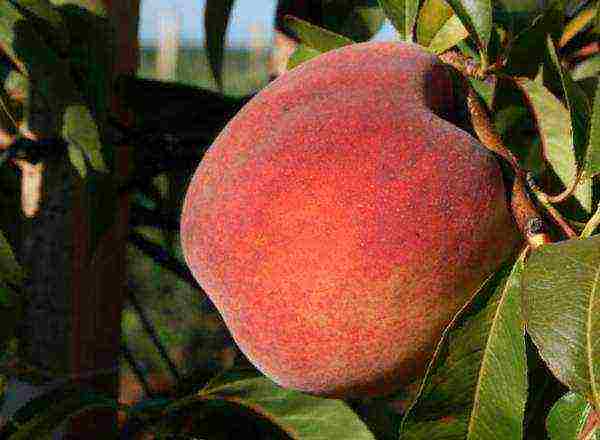 The best late-ripening peach varieties: Fury, Frost, Veteran
The best late-ripening peach varieties: Fury, Frost, Veteran
Veteran grade differs from late-ripening varieties in that it quickly enters the fruiting phase and has a low growth. The size of the fruit is also not impressive (no more than 150 g).
They love it for its good taste. It is ideal for conservation.
Self-fertilized, self-fertile peaches: Inka, Vulcan, Harnas, Golden Jubilee
Self-pollinated varieties are very popular among gardeners. To increase fruiting, it is recommended to plant several plants for cross-pollination... But one tree will also bear fruit.
Among self-pollinated, self-fertile varieties, a good harvest in a single planting gives Inka, Volcano, Harnas, Golden Jubilee.
Harnas belongs to winter-hardy, early-ripening dessert varieties. It is a vigorous tree that bears fruit regularly. Its peculiarity is that the fruits hold tightly to the branches and do not fall off.
Early maturing varieties are distinguished by high winter hardiness of trees and flower buds. They can withstand recurrent frosts. This makes it possible to grow them not only in the southern latitudes, but also in the middle lane, as well as in Siberia and the Urals.
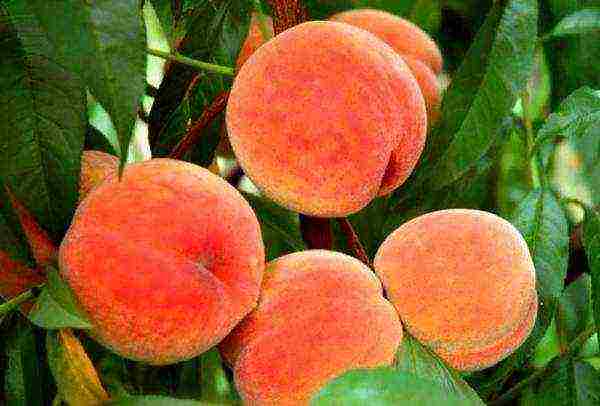 Self-pollinated peach varieties: Inka, Volcano, Harnas, Golden Jubilee
Self-pollinated peach varieties: Inka, Volcano, Harnas, Golden Jubilee
In the regions of Siberia, it is necessary to protect trees from recurrent frosts.
Mid-season varieties build up a decent crown and only then please with a rich harvest. The disadvantage is that it is difficult to form branches, but a regular and generous harvest allows you to turn a blind eye to this.
Mid-season varieties often bent downward to facilitate harvesting.
The lack of late-ripening varieties isthat they can only grow in a certain area. But if climatic conditions allow, then these trees will not only decorate the garden, but also delight you with delicious fruits.
When planting a peach, it should be borne in mind that all varieties bloom very early, when there are still few pollinating insects. You can help the plant by gently shaking the upper branches so that the pollen falls on the lower inflorescences.
Plants respond well to fertilizing and watering... Water plays an important role in the formation of fruits. Its quantity depends not only on the size of peaches, but also on their taste and aroma.
Give your seedlings a little attention and care so that they can turn into beautiful trees and please with the harvest every year.
 Previously, a peach in the country could be considered a tourist attraction, but today you can find a wide variety of varieties on your own plots. The only problem is choosing the right variety so that it can cover all your requirements and produce a good harvest every year.
Previously, a peach in the country could be considered a tourist attraction, but today you can find a wide variety of varieties on your own plots. The only problem is choosing the right variety so that it can cover all your requirements and produce a good harvest every year.
And, it is true, even a dozen or two years ago there were not so many peaches in the dachas, but now, when you can buy high-quality seedlings in any city or village, many summer residents plant a culture in the garden and expect juicy, fleshy and very sweet fruits. Unfortunately, not all hopes are justified, because in order to grow a high-quality crop, you need to choose the right variety for your region, for the soil and climate, and many more criteria.
Today we decided to explore some varieties of peach, which, in our opinion, are the most worthy to settle in the country. It should be understood that a variety is suitable for each region.

Early peach varieties 2018
The fruits of the early varieties can be tasted in the first half of summer. But for this it is necessary to choose a high-quality seedling and plant it on the site, according to agricultural technology.
Also read: Planting carrots by seeds
The plant shows high yields and excellent resistance to powdery mildew and clotterosporosis. The early Kiev does not like excessive dryness of the soil, but it also has an extremely negative attitude to waterlogging.

Redhaven
If you are looking for a really juicy and tasty variety for a summer residence, Redhaven is excellent for you. This is a visiting variety that is perfectly adapted to local growing conditions, and therefore can show good results, both in private and industrial breeding.
Redhaven produces large fruits, sometimes more than 150 g, which are distinguished by excellent taste (practically the highest tasting rating). The color of the fruit is orange-yellow, with red spots or blotches, the flesh is yellow, tender, with a pleasant and very strong aroma. That is why children like Redhaven so much, and adults do not mind trying an excellent peach with an unforgettable taste.
The variety is resistant to winter and spring frosts, curliness and many other diseases, but it is affected by fungal diseases, especially with improper agricultural technology. But, you can always protect a tree from diseases if you fertilize and stimulate growth and development in time, as well as take preventive measures that experts advise in relation to each individual variety.

Collins
If you like large peaches, we recommend that you pay attention to the Collins variety. The weight of the fruit is about 150 g, the taste is sweet with a light and very pleasant sourness, the color is red-yellow interspersed.
The peach is very productive, and therefore the fruits must be removed from the tree in time so that the crop does not break the branches. Try to pick peaches consistently, as they do not ripen at the same time, but over a period of time.
This variety is resistant to curliness and powdery mildew, perfectly tolerates winter and spring frosts.
A feature of the variety can be called a great need for top dressing, regular watering and timely pruning with crown formation. Only a well-groomed tree can please you with a stable harvest of large fruits.
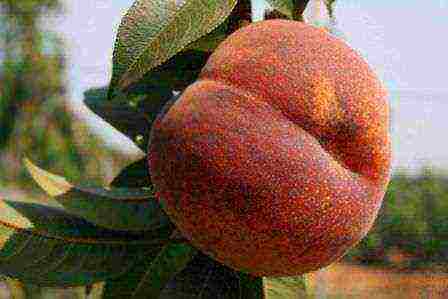
In addition to the varieties we have indicated, you can always plant other early varieties in the country, for example, Juicy peach and Favorite Moretini.
Medium to late ripening peaches
There are quite a lot of fruits in the country that yield early harvest, and therefore some summer residents prefer later varieties of peaches. Perhaps the reason is the consistent use of delicious vitamins throughout the warm season. Let's choose the best varieties of late ripening peaches for planting in the country.
Cardinal
The variety attracts with its persistent charm, because each individual fruit is a real masterpiece. Average size, weight 140 g, carmine blush, sometimes replaced by pure yellow skin ... and if we talk about taste, then you can forget here at all, because 5 points on the main tasting scale is the height of perfection. Of course, there are other juicy, sweet and aromatic varieties, but Cardinal is definitely among the leaders.
Planting material can always be found on sale, but purchasing a seedling is just the beginning, because this variety will require special care from you, since it does not tolerate frosts very well.
If we talk about diseases, then powdery mildew is not terrible for Cardinal, and this is seriously pleasing. Try to constantly keep the plant in good shape, supply it with fertilizing and moisture in time, because the formation of a large crop requires constant replenishment.

Kremlin
It adapts perfectly to almost any naturally reasonable conditions. This characteristic makes the Kremlin variety very popular, despite the fact that it does not show fruits of a particular size at a constant level, although some trees bear peaches under 200 g in weight.
The fruits are orange or yellow, with a red blush or extensive blotches, very juicy and aromatic, sweet or sour-sweet taste.
The variety is not very susceptible to many diseases and shows high winter hardiness, which is very good for regions with cool climates.
It should be grown under standard conditions, but try to carefully monitor watering, since trees do not really like strong moisture. Therefore, it is necessary to plant them on flat areas or hills, and rarely water them, but systematically.
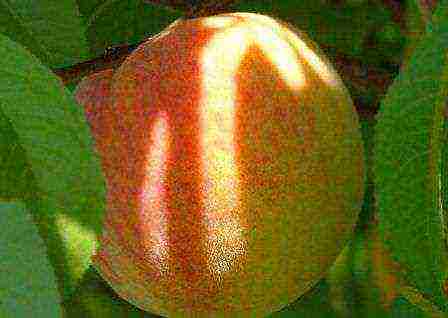
The description of peach varieties will only give you basic information for choosing seedlings. In the future, you have serious work on growing, caring for and reproducing.
New varieties of 2018
Sunrise, Golden Jubilee, White Swan, Veteran, Ambassador of Peace, Redgold, Flavertop, Bohun, Greensboro, Jaminat, Krasnodarets, Raduzhny, Stavropol, Elberta - all known varieties that can often be seen in the country, but we would like to introduce you to American and Canadian peach varieties that are adapted to our climate and show excellent yield results.
Among these varieties there are nectarines, fig peaches, frost-hardy and simply winter-hardy varieties: Harbinger, Harrow Diamond, Harnas, Earley Redhaven, Harco, Suncrest, Inka.
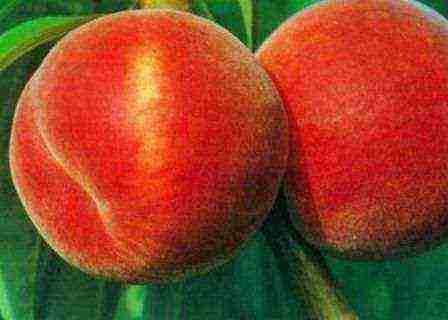
We perfectly understand that it is quite difficult to choose the right varieties of peaches for a summer residence., but you need to make the right choice if you want to receive large, sweet, juicy and fragrant fruits of a wonderful plant during the summer, or even at the beginning of autumn. Be careful, because you need to purchase not just a selection variety, the description of which you liked, but a necessarily adapted seedling, preferably famous or generally advised to you by a neighbor, a summer resident, who has been harvesting crops from trees for several years. Of course, you can always go to online stores or botanical gardens, but then at your own peril and risk.

Peach varieties and the best harvests (video)
After purchasing a seedling, be sure to study its proper planting and care in the first few years after planting - this is the main period when the plant needs care. In the future, of course, agricultural technology should also be followed, but, like any mature plant, a peach will no longer require as much attention from you as it does at once.
Attention, only TODAY!
Reviews and comments
Did you find a mistake in the text? Please select it and press Ctrl + Enter. Thank you!
Rating:
(
estimates, average:
out of 5)

Peach blossom
Peach is a fruit tree of the Rosaceae family. The ancestor of the peach is the almond. During the flowering period, the tree is covered with beautiful pink flowers that appear earlier than the leaves. The plant originated in China. China is the largest exporter of peaches to Russia and other countries.
This is a very thermophilic and light-loving tree, therefore it prefers to grow in the southern part of Russia, Transcaucasia, Ukraine, America, Italy, China, etc.
But, with proper care, peaches can also be grown in regions with cold winters. Currently, varieties have been bred that have good winter hardiness. When buying seedlings, you need to pay attention to the resistance of the variety to frost and frost.
Peach bloom begins in mid-April and lasts an average of 10 days.
Fruit ripening, depending on the variety, begins in 3 - 4.5 months. Fruits on early varieties of trees are ready for consumption after 3 months, on medium-early varieties - after 3-4 months. Late varieties ripen in 4.5 months.
Peach fruits differ in shape, taste, roughness, depending on the varieties. The average fruiting period of a peach tree is 15 years.
The most popular early varieties include:
Favorite Morettini

Favorite Morettini
Maturation - early July
Italian variety with fruits weighing 70-90 grams. Fruiting begins in the second or third year after planting. The fruits are yellow with a red blush, the skin is rough with a pronounced seam in the middle, the taste is juicy and sweet. The shelf life of fruits is 3-4 days, and therefore this variety is extremely inconvenient for transportation. Has an average winter hardiness.
Kiev early
Maturation - mid-July
It is an industrial grade. The trees are of medium height and have a spherical crown. Fruiting of Kiev early begins in the third year of planting. It is quite winter-hardy, withstands temperatures up to -25 degrees. Fruits ripen by mid-July. The variety is high-yielding - up to 50-70 kg of peaches per tree. The average fruit weight is 90-150 grams.
Collins
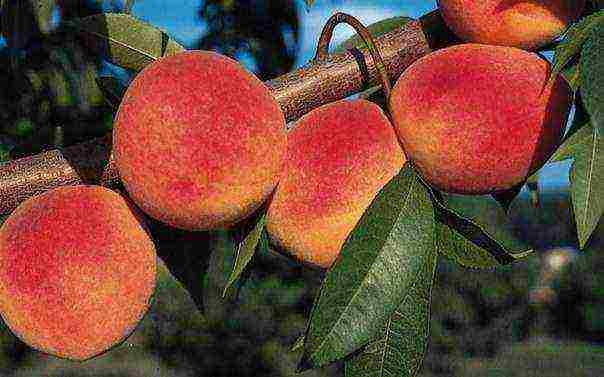
Collins variety
Maturation - end of July
The tree is quite tall, it can reach 6 meters. Sufficiently resistant to frost, powdery mildew and curliness. Fruits appear in the second year of planting. Average yield - 30 kg per tree. The average fruit weight is 110 grams. Peach color is yellow-red.
Greensboro
Greensboro variety
Maturation - early August
The tree has an extensive crown and high growth. This variety is often found in the Crimea, the North Caucasus, Moldova, Georgia, and southern Russia. Fruits - up to 120 grams. The peel is pubescent, thick, dense, rough, the fruits have a sweet and sour, juicy taste. Bears abundantly. Not suitable for cold winters, where frosts exceed -20. Disease resistant. Poorly tolerates transportation and storage.
Redhaven
Variety "Redhaven"
Maturation - first half of August
Redhaven is one of the most popular and delicious varieties. It has large and juicy fruits (Redhaven means "Red Paradise"). Produces abundantly - up to 100 kg per tree. The average fruit weight is 200 grams. Good transportability. Resistant to frost, curliness. Susceptible to diseases of powdery mildew and clotterosporia. We self-pollinate, but for better yields, peach trees of other varieties can be planted in the neighborhood.
Redhaven prefers medium acid soil. Requires frequent fertilizing after planting.
Juicy
Variety "Juicy"
Maturation - first half of August
Tall trees with a broad crown. The variety is self-pollinated, fast-growing, has a high yield. Fruit weight - up to 120 grams. The skin is thick, with a dense roughness. This variety is very winter-hardy, but has a low shelf life and low transportability. Has a tendency to get sick with powdery mildew.
Mid-early varieties include:
White Swan
Variety "White Swan"
Maturation - second half of August
This is a dessert variety of peach, it has a high sugar content. Very good for making compotes, jams, desserts, wine. A tree with an extensive crown, up to 6 meters high, has a high yield, excellent frost resistance - up to -25. This variety is resistant to dry weather and disease. Fruit weight reaches up to 250 grams. The color of the peaches is yellow with a pink tint. The fruits tolerate travel and long-term storage well.
Golden jubilee
Variety "Golden Jubilee"
Maturation - second half of August
The fruits of this variety are transportable and have excellent taste. The average weight is 150 grams. The skin is edged, dense, with a golden yellow tint and a dark red blush. The shelf life is up to 8 days. "Golden Jubilee" has good winter hardiness and high yield - up to 50 kg per tree. Begins to bear fruit from the age of three.
Forest-steppe early
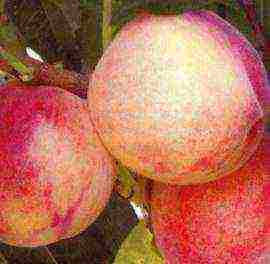
Variety "Forest-steppe early"
Maturation - second half of August
The variety has increased resistance to cold winters and early frosts. Medium-sized tree with a wide crown, medium density. Fruiting begins in the fourth year after planting. Good powdery mildew resistance. The average fruit weight is 110 grams. Peach color is creamy, with a pink blush, rough. The taste is sweet and sour, juicy, very pleasant. Storage - 5-8 days from the date of collection.
Of the late varieties of peach, I would like to highlight:
Veteran
Variety "Veteran"
Maturation - end of August
High self-pollination. Fruiting begins at the age of 3. High winter hardiness. Fruit weight reaches 130 grams. The fruits have medium pubescence, light yellow rind, and juicy flesh. The variety has high winter hardiness, high resistance to diseases, and is well transported.
Sunny Jaminat
Variety "Sunny Jaminat"
Maturation: first half of September
The trees of this variety are not very tall, the crown is spherical and not dense. The variety gives a high yield, the fruits are large, the average weight of the fruit is 160-200 grams. Peach color is bright yellow with red blotches. The taste is very juicy, sweet, with a slight sourness.
Fruiting of the variety begins in the third year after planting. Trees love warm climates and do not tolerate frosts very well. It is necessary to protect plants from diseases and pests, since they are susceptible to curliness and clotterosporia.
The fruits of this variety are highly transportable. They perfectly retain their appearance and taste up to two weeks from the date of collection.
Irganai late

Irganayskiy late variety
Maturation: first half of September
Fruits are bright yellow with red spots, rough. The pulp is juicy, tasty, very tender. The average weight of a peach is 140-150 grams.
The crown of the tree is spreading, spherical, dense. The variety tolerates spring frosts well, but severe frosts are destructive for it. Fruiting is average. Susceptible to diseases of klyasternosporiosis and powdery mildew, curliness.
The fruit has a shelf life of up to 10 days, so the variety is excellent for transportation and sales. The disadvantage is the beginning of fruiting - this variety begins to bear fruit only in the fifth year after planting!

Peach varieties include 6 species, of which two are widespread on the territory of the former USSR: common peach and Fergana peach (distinguished by flattened fruits). The native land of the peach is considered to be Northern and Central China, where all known species of this genus are still found in the wild.
Description
Even before our era, the common peach as a culture began to spread in a southern and western direction, as it were, along the main trade routes and reached the Mediterranean countries, but even before that, ancient Persia had become a secondary center of its cultivation. From her, the peach got its name - the ancient Romans called it "the Persian apple".Later, this fruit crop spread to all southern countries and even crossed the ocean (one of the world's leading countries for the production and consumption of peaches is the United States).
Peach has taken root in the southern regions of Ukraine up to the Carpathians, where it is cultivated on an industrial scale, and in amateur farms it is grown both in Polesie and in the forest-steppe.
Unlike the common peach, the Fergana peach is an endemic crop, however, through the efforts of breeders, its genetic material was used to create some modern varieties.
Biological features
Peach is a tree 5-7 m tall with a pronounced trunk, but now you can find its bush forms. Blooms in April-May, leaves appear after flowering. Peach is the largest-fruited crop among the common stone fruits in our country (nectarine has become its competitor relatively recently), its fruits can reach up to 10 cm in diameter, they are round-oval, greenish or yellow-orange, in many varieties - with a bright blush of red tones, covered with dense skin with pubescence. The stone is large, with a hard furrowed skin.
Peach is a self-fertile culture, specimens grown from its seeds have properties close to the maternal, however, a full set of varietal characteristics is still transmitted only during reproduction by grafting.
Among fruit crops, peach is the most thermophilic, least winter-hardy and fastest growing plant. It needs a lot of heat and light to get quality fruits. In this it surpasses even the apricot. In most regions, the distribution of peach is limited due to early and late spring frosts, although it can withstand very low temperatures in winter. Her drops are especially harmful to him.
In Ukraine, for industrial culture, its favorable conditions are available only in the Crimea and the coastal regions of Odessa, Kherson, Nikolaev, Zaporozhye regions and in Transcarpathia. In the more northern regions of Ukraine, only one variety can be grown - Kievsky early, which in terms of winter hardiness exceeds all other varieties and is recommended for growing in 14 regions of Ukraine.
Beneficial features
Peach fruits are valued primarily for their juiciness and taste; they can be used both fresh and processed (jam, jams, jam, candied fruit, jelly, etc.), as well as dried.
The fruit pulp contains up to 15% sugars, organic acids (malic, citric, etc.), ascorbic acid, essential oil consisting of linalol esters of formic, acetic, valeric and caprylic acids; acetaldehyde and cadinel. The content of vitamin C in them is average, but they serve as a source of vitamins E, B2 and many micro-elements, in particular potassium and iron.
Peach fruits promote the formation of hemoglobin, improve cardiac activity and liver function and have a cleansing, laxative and diuretic effect; in dietary nutrition, they are also used as a general tonic.
The kernels of the seeds contain up to 57% fatty oil, which includes glycerides of palmitic, oleic and stearic acids (15.6%), sitosterol, amygdalin glycoside (0.4-0.7%) and essential bitter almond oil.
The flavonoids naringenin and peacoside are found in the bark.
The leaves are used for diabetes, rheumatism, headaches and some gastrointestinal diseases.
The best varieties
In Ukraine, 21 varieties of peach have been zoned: 15 varieties of Soviet selection, 5 foreign and 1 local folk. In the State Register of the Russian Federation, 17 varieties of peach are registered, all are zoned only for the North Caucasus region, however, amateurs grow a peach (not always successfully) even in the middle lane, bringing grafted seedlings there from the south or growing seedlings from seeds. In total, there are about 3000 varieties of peach in the world.
Friendship.The variety is of medium ripening (mid-August), obtained from sowing seeds of Chinese origin, but is distinguished by increased winter hardiness. The tree is vigorous, with a spreading or slightly flat crown (height and width 4 m). Annual shoots of medium thickness, on the illuminated side have a slightly crimson blush, on the shady side they are monotonously green.
Fruits are round, large (140-160 g) or very large (200-250 g). The abdominal suture with pronounced protruding ribs, especially at the apex of the fruit. The dorsal side is wide and smooth. The skin is thin, tender, elastic, with hardly noticeable pubescence, easily separates from the pulp. The main color is creamy yellow, the blush in the form of strokes and dots occupies approximately half of the fruit. The pulp is whitish-creamy, very juicy, sweet, of high taste (tasting score - 5 points). The stone is large, easily separated from the pulp.
Valery Chkalov. Zoned in Ukraine in the Kherson region. Mid-season table variety. Bred in the Nikitsky Botanical Gardens I. N. Ryabov from the stone of the Elbert variety. The trees are small, for the conditions of the south of Ukraine they are quite winter-hardy, they are distinguished by their early maturity and high productivity. The fruits are large (140-150 g), oval, greenish-yellow with a dark red blush. The pulp is yellow, medium density, fibrous, with a pleasant harmonious taste. The bone is easily separated from the pulp.
Golden jubilee. The variety is zoned in Ukraine in the Transcarpathian and Crimean regions; outside Ukraine - in Russia in the North Caucasus; in Azerbaijan, Georgia, Moldova, Turkmenistan and Uzbekistan. Mid-season table variety, bred in the United States around 1920.
The trees are large, with a spreading crown, come into fruiting in the third year, are fruitful. Winter hardiness of flower buds and resistance against perforated spot and powdery mildew are average, against curly leaves - weak. Fruits are large or medium-sized (130 g), oval, golden yellow with a red blush. The pulp is orange-yellow, dense, delicately fibrous, juicy, aromatic, of excellent taste. The fruits are harvested in Crimea in late July - early August, they are good for fresh consumption, partially suitable for canning and drying.
Kiev early. The variety is zoned in Ukraine in Vinnytsia, Dnepropetrovsk, Donetsk, Zaporozhye, Kiev, Kirovograd, Lvov, Nikolaev, Odessa, Poltava, Ternopil, Kherson, Khmelnitsky and Chernivtsi regions; outside of Ukraine is cultivated in Kazakhstan. The variety was bred at the Ukrainian Research Institute of Horticulture by crossing the Kashchenko 208 seedling with the Gross Mignon variety.
The trees are medium-sized, with a rare wide-pyramidal crown, highly winter-resistant, undemanding to growing conditions, high-yielding. They begin to bear fruit in the third year, and in the fourth they already give marketable yields. Fruits are medium-sized (75-100 g), round-elongated, light yellow, sometimes with a bright striped blush. The pulp is greenish-white, juicy, with a pleasant taste. In the southern regions of Ukraine, the fruits ripen in the second, and in the central ones - in the third decade of July.
Red-cheeked peach. The variety is zoned in Ukraine in the Crimean and Odessa regions; outside the country - in Russia in the Krasnodar Territory. Table variety of early middle ripening period. Bred by IN Ryabov in the Nikitsky Botanical Garden by crossing the varieties Koroleva Olga and Early Rivers. The trees are medium-sized, winter-hardy in the conditions of the Crimea. They begin to bear fruit in the third year, they give fairly good stable yields. The fruits are large (average weight 135 g, maximum 200 g), broadly oval, greenish-creamy with a beautiful bright crimson blush. The pulp is greenish-white, moderately fibrous, juicy, of good taste. The fruits ripen at the end of August.
Kremlin. The variety is zoned in Ukraine in the Transcarpathian, Crimean and Odessa regions; outside of Ukraine is cultivated in Russia in the Krasnodar Territory.Mid-season table variety, bred in the Nikitsky Botanical Garden by I. N. Ryabov by crossing the varieties Rochester and Elbert.
The trees are vigorous, with a broadly oval, slightly spreading crown, rather winter-hardy, not resistant to clasterosporium disease. The yield is high, but irregular. Fruits are above average size (106-200 g), almost round, yellowish-orange with a bright red blurred blush. The pulp is yellowish-orange, fibrous, of medium density and juiciness, aromatic, very good taste. On the South Coast, the fruits ripen in mid-August.
Rosy. The variety is bred on the basis of seeds of Chinese origin. Differs in increased winter hardiness. Vigorous tree (height 4 m, width 3.5 m), with a spreading crown.
Annual shoots are thick, crimson on the lighted side, green on the shady side. Fruits are round, large (110-130 g, some up to 150 g). The abdominal suture is clearly defined, with prominent ribs. The skin is thin, with subtle gentle pubescence, elastic, easily separated from the pulp. The color is creamy yellow, with a dotted blush that occupies almost the entire fruit. The pulp is creamy white, pale pink near the stone, very juicy, aromatic, of excellent taste (tasting score - 5 points). The stone is medium in size.
Soviet. The variety is zoned in Ukraine in the Crimean and Odessa regions; in Georgia and Moldova. Mid-season table grade. Bred in Nikitsky Botanical
garden I. N. Ryabov from crossing the varieties Golden Jubilee and Narinji late.
The trees are medium-sized, with an almost spherical crown, moderately hardy, in rainy years they are affected by perforated spots. Begin to bear fruit in the 2-3rd year.
Fruits are above average (100-150 g), dull-oval, greenish-yellow with a beautiful blush. The pulp is yellow, non-fibrous, juicy, aromatic, of good or very good taste. Fruits ripen in late July - early August. In favorable conditions, they have good regular productivity; in the steppe regions of Crimea, they give birth irregularly.
Juicy. The variety is zoned in Ukraine in the Zaporozhye, Crimean, Nikolaev, Odessa and Chernivtsi regions; outside it is cultivated in Russia in the North Caucasus and in Moldova. Early ripe table variety. Bred in the Nikitsky Botanical Garden by IN Ryabov from crossing the varieties Rochester and Greensboro.
The trees are vigorous, winter-hardy, moderately resistant to clotterosporia, medium-yielding. Fruits are above average (100-200 g), broadly oval, green-creamy with a beautiful blurred blush. The pulp is white or greenish-creamy, medium-fiber, very juicy, aromatic, of good taste. Ripening occurs in late July - early August.
Growing
Sandy loam and loamy soils are optimal for cultivating peaches; it does not like heavy clay soils. The groundwater level should not be high, especially the peach does not tolerate the combination of cold and dampness. It is better to plant peaches in areas with a southern orientation.
Reproduction
You can propagate a peach by seed (the quality of the fruit in this case is likely to be lower) and by grafting. When grafted onto rootstocks of other species, the peach partially adopts their qualities. So, when grafted on cherry plum, it can grow on clay soils, on almonds - on dry and gravelly soils, on apricots - in arid regions.
Agrotechnical measures for peach are the same as for other fruit trees: careful weeding of near-stem circles; periodic (2-4 times per summer) watering (very moderate - in case of their excess, as in a too rainy summer, the peach may stop bearing fruit) and loosening.
The crown of peach trees is usually bowl-shaped (leaderless), as this shape allows most branches to have better access to light.
In the forest-steppe conditions of Ukraine, the peach is often formed in the form of a bush with 3-4 boles.
Generative peach buds should be thinned so that no more than 5 fruits remain on one link - this will increase their quality.
Pests and diseases
The main enemies of the peach are powdery mildew, leaf curl and clotterosporium disease.
